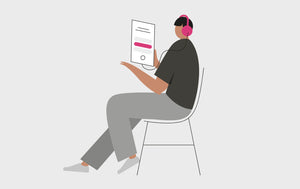
The pros and cons of ear syringing
The build-up of earwax and how to manage it is a subject that baffles many of us. With the help of our audiologist Bev, we’ve put together some frequently asked questions and answers to help shed light on the problem.
What is earwax micro-suction?
Earwax micro-suction is a procedure that gently removes a build-up of earwax from the ear canal. A bit like the hose of a vacuum cleaner, it relies on suction power. It is usually a simple process that takes between 5-20 minutes to perform. Occasionally, two sessions may be required for particularly stubborn blockages to avoid damaging the ear-canal.
It is quite normal for those with excessive earwax production to require treatment every 3-6 months.
Why have doctors stopped syringing?
Water syringing is an alternative procedure which for many years was available at your GP practice. Unfortunately, this is no longer widely available on the NHS. This is in the main a result of cost cutting, time pressures and the associated infection risks of the procedure.
The majority of GP surgeries no-longer provide the service.
Can I syringe my own ears at home?
Syringing your ears is NOT something we would recommend you try at home. Every ear is different as ear canals vary in size, shape and orientation. If you apply too much pressure, you could do severe damage, not just to your ear drums but your hearing in general. Syringing your ears with water could lead to fluid becoming trapped behind the wax obstruction. Trapped water can lead to infection. It is best to seek professional help from the start.
How do I know if my ears are blocked and need syringing?
- You may experience some hearing loss, particularly in the low frequencies.
- It can make your own voice sound hollow, as if you are speaking into a bucket.
- You may feel a fullness in your ear.
- For some, it can be painful and uncomfortable.
So where can I go if I need my ears syringed?
Firstly, it is always worth checking with your GP to see if you qualify for help via the NHS. If the answer is ‘no’, you could consider earwax micro-suction, performed by a trained audiologist. Engaging an expert is the best way to safeguard your hearing.
Simply enter “earwax micro-suction clinic near me” into Google and it should generate a list of licensed organisations who will be able to help you.
Is ear syringing safe?
If carried out by an expert, earwax micro-suction is usually a simple procedure that leads to few complications. Even so, there is always a risk of an infection developing after the event, or indeed discovering an ear infection already exists behind the blockage. To minimise the risk, it is best to keep your ears dry for a few days after treatment and avoid poking your fingers, or an ear bud into your ears. If you take a shower, don’t submerge your ears in water. They will be rather sensitive at first, so give them time to settle down. If you experience any pain, go back to your audiologist to get them checked out.
How do I prepare for earwax micro-suction?
The key element to success is creating soft ear wax before you go. A product such as Earol – an olive oil based spray, or Audiclean – a cleansing ear-wash will help soften the blockage sufficiently for it to be removed safely. If your earwax is already soft, it may dislodge the blockage completely, without the need of further help.
Before using any of these products, please remember to remove your hearing aids for the duration of the treatment.
Is there another way of getting rid of earwax?
There are more gentle ways to remove excessive earwax. It usually involves dissolving the earwax with an oil or specially treated water that can be applied at home. It just takes some patience. There are many products on the open market that claim to help you with this issue. We stock just two:
Earol – an olive oil based product that will gently soften the wax in your ear, before both the oil and wax naturally migrate out, usually as you sleep. It can take up to ten days to work and we would suggest you use an old towel on your pillow to avoid staining.
Earol can leave an oily residue in the ears which in turn, can make you feel more blocked up than you did before. Your hearing as a result can appear worse for a while, which some people find disconcerting. It is only a temporary side-effect and will subside as the wax clears. It can work brilliantly at softening even the hardest of earwax blockages.
For some, the problem will be solved. For others, if after seven days there is no improvement, you may wish to consult a clinic for an earwax micro-suction appointment.
Audiclean – is an isotonic seawater which can be sprayed directly into your ears. It can help remove a blockage if the wax is already relatively soft. For a harder, more stubborn obstruction, an oil based product may be a better solution.
Medical Grade Coconut Oil – available over the counter at most pharmacies is naturally both anti-bacterial and anti-fungal. This is particularly useful for those who suffer from eczema. Unlike an olive oil based product, it doesn’t leave a residue and will naturally absorb into the skin.
What causes excessive earwax production?
Excessive earwax can be generated by a number of factors:
Hearing aids create a warm environment in the ear canal, ideal for wax generation.
- Warm, humid weather can lead to a sudden increase in earwax.
- Excessive earwax can be a hereditary trait.
- Sometimes it is dead skin not earwax causing a blockage.
- Small ear canals can be problematic and are often more likely to require suction.
- Listening to music using in-the-ear headphones can stimulate wax production.
- Using earbuds in the ear canal can artificially compact ear wax, forcing it deeper into the ear. It can also leave residual fibres that can lead to infection.
For further information, please don’t hesitate to contact a member of our team who will be happy to help.


